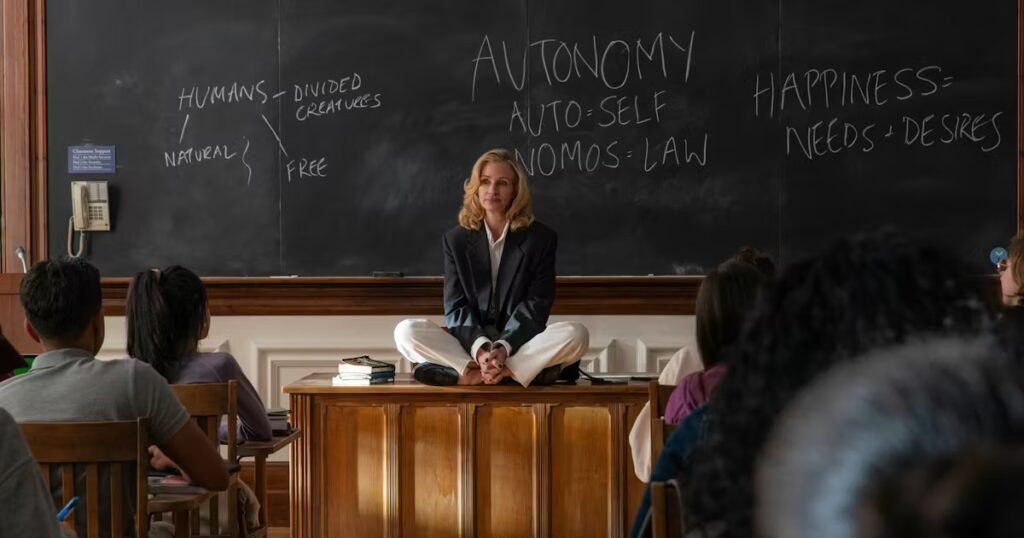After the Hunt: A Deep Dive into Luca Guadagnino’s Psychological Thriller
In Luca Guadagnino’s After the Hunt, the boundaries of morality blur, showcased through a haunting narrative and meticulously crafted costumes. Following a prolific year marked by the releases of Challengers and Queer, Guadagnino reunites with costume designer Giulia Piersanti, head of knitwear at Céline, to explore academia-chic styles. This duo’s enduring collaboration begins from a foundation of friendship and trust, evident through their shared vision to bring characters to life by creating mood boards that reflect their inner struggles and intentions.
The Impact of Costume Design
Costume design serves not merely as frivolous adornment; rather, it offers profound insights into character development. In After the Hunt, Piersanti’s styles range from classic suits to luxurious jewelry, highlighting the film’s central conflict. Julia Roberts portrays Alma, an esteemed philosophy professor at Yale who finds herself engulfed in turmoil when her protégé, Maggie, played by Ayo Edebiri, accuses a close friend of sexual assault. As Alma’s situation deteriorates, so does her wardrobe, shifting from pristine monochrome suits to more chaotic ensembles.
Discover the intricate relationship between costumes and psychological depth on W Magazine.
The Duality of Alma (Julia Roberts)
Alma’s character is a study in contrasts—an intellectual caught between poise and turmoil. Piersanti captures this duality through an elegant white suit by Totême, the epitome of sophistication during a critical dinner scene. “This moment before the storm showcases Alma’s confident allure,” Piersanti notes. However, as Maggie’s accusations unravel the foundations of Alma’s world, her clothing reflects this emotional unraveling. The pristine suit is traded for casual, disheveled pieces—cream shirts and gray sweaters that symbolize Alma’s increasing vulnerability.
Every piece in Alma’s wardrobe is a choice, illustrating her depth. As Piersanti remarks, “Alma could exist in any period; her style is timeless and above trends.”
The Transformation of Maggie (Ayo Edebiri)
Maggie’s character arc intricately intertwines with Alma’s, initially displaying admiration that morphs into something more complex. Influenced by Alma’s style, Maggie’s look is a youthful interpretation of her mentor’s wardrobe. From structured blazers to matching black nail polish, Maggie shows her attempts to emulate Alma, culminating in the character’s confrontation with her idol.
Importing elements from current student street style, Piersanti creates garments that reflect Maggie’s struggle—dark denim and casual cardigans balanced with academic preppiness. “She is not trying to flaunt wealth,” says Piersanti, which anchors Maggie’s character within a grounded reality.
The evolution concludes in a final scene where time has passed, marking a significant transformation in both characters. While Alma’s style remains cozy and intellectual, Maggie opts for a soft Wales Bonner dress, signaling her departure from imitation into a newfound identity.
Hank’s Decline (Andrew Garfield)
Hank, played by Andrew Garfield, serves as a catalyst for much of the film’s tension. His character transitions from a charming professor to a figure plagued by chaos, effectively conveyed through his disheveled wardrobe. Piersanti draws inspiration from young Harrison Ford’s casual styles to illustrate Hank’s descent into turmoil.
As the narrative progresses, Hank’s outfits—typically simple denim and button-ups—become indicative of his fractured mental state, reflecting a man slipping through the fingers of control. “His clothing becomes messier as his sanity unravels,” Piersanti explains, providing depth to his character’s crisis.
For a deep dive into character dynamics and expressions, you can read more about Hank’s transformative style on Variety.
The Depth of Character Relationships
The interplay between Alma, Maggie, and Hank goes beyond mere plot; it embodies the exploration of power dynamics and trust in academia. Each character’s wardrobe is an extension of their emotional state, facilitating interactions laden with tension. Piersanti notes Hank’s contrasting looks with Alma serve to heighten their disconnection—Hank’s relaxed dishevelment plays against Alma’s structured elegance, underscoring their polarizing worlds.
In contrast, Miguel Stuhlbarg’s character, serving as Alma’s husband, showcases sharp tailoring that complements the film’s primary themes of control and elegance. Piersanti incorporates designs like Comme des Garçons, reflecting the sophistication expected from an academic milieu while diverging from traditional styles.
Conclusion: More Than Meets the Eye
Luca Guadagnino’s After the Hunt transcends the typical psychological thriller through its poignant exploration of human relationships, power struggles, and moral ambiguity. Piersanti’s costume design serves as a silent narrator, revealing characters’ inner lives and transformations that resonate deeply.
In a world often seen as binary, After the Hunt challenges viewers to navigate the complexities of truth and deception—each character, with their distinctive wardrobe choices, ultimately results in a narrative that invites reflection long after the credits roll.
For a deeper dive into the psychological intricacies explored in After the Hunt, visit IndieWire.
This film stands out not just for its storytelling, but for the way its visual elements marry seamlessly with profound themes that captivate audiences, prompting viewers to ponder the shades of grey in humanity.





